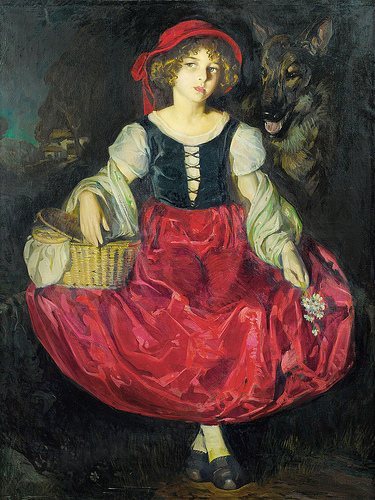Once upon a time there was a little village girl,the prettiest that had ever been seen.Her mother doted on her. Her grandmother was evenfonder, and made her a little red hood,which became her so well that everywhere she wentby the name of Little Red Riding Hood.One day her mother, who had just made and bakedsome cakes, said to her:for I have been told that she is ill.Take her a cake and this little pot of butter.'Little Red Riding Hood set off at once for thehouse of her grandmother,who lived in another village.On her way through a wood she met old Father Wolf.He would have very much liked to eat her,but dared not do so on account of somewood-cutters who were in the forest.He asked her where she was going.The poor child, not knowing that it was'I am going to see my grandmother,and am taking her a cake and a pot of butterwhich my mother has sent to her.''Does she live far away?' asked the Wolf.'Oh yes,' replied Little Red Riding Hood;'it is yonder by the millwhich you can see right below there,and it is the first house in the village.''Well now,' said the Wolf,'I think I shall go and see her too. I will go by this path,and you by that path,and we will see who gets there first.'The Wolf set off running with all his mightby the shorter road, and the little girlcontinued on her way by the longer road.As she went she amused herself by gathering nuts,running after the butterflies,and making nosegays of the wild flowerswhich she found.The Wolf was not long in reaching the grandmother's house.He knocked. _Toc Toc._'Who is there?''It is your little daughter, Red Riding Hood,'said the Wolf, disguising his voice,'and I bring you a cake and a little pot of butter as a present from my mother.'The worthy grandmother was in bed,not being very well, and cried out to him:'Pull out the peg and the latch will fall.'The Wolf drew out the peg and the door flew open.Then he sprang upon the poor old lady and ateher up in less than no time,for he had been more than three days without food.for Little Red Riding Hood.Presently she came and knocked. _Toc Toc._'Who is there?'Now Little Red Riding Hood on hearing the Wolf'sgruff voice was at first frightened,but thinking that her grandmother had a bad cold,she replied:'It is your little daughter, Red Riding Hood,and I bring you a cake and a little pot of butterfrom my mother.'Softening his voice, the Wolf called out to her:'Pull out the peg and the latch will fall.'Little Red Riding Hood drew out the peg and thedoor flew open.When he saw her enter, the Wolf hid himselfin the bed beneath the counterpane.'Put the cake and the little pot of butter on thebin,' he said, 'and come up on the bed with me.'Little Red Riding Hood took off her clothes,but when she climbed up on the bed she wasastonished to see how her grandmother looked inher nightgown. 'Grandmother dear!' she exclaimed,'what big arms you have!''The better to embrace you, my child!''Grandmother dear, what big legs you have!''The better to run with, my child!''Grandmother dear, what big ears you have!''The better to hear with, my child!''Grandmother dear, what big eyes you have!''The better to see with, my child!''Grandmother dear, what big teeth you have!''The better to eat you with!'With these words the wicked Wolf leapt uponLittle Red Riding Hood and gobbled her up.
'Grandmother dear!' she exclaimed,'what big arms you have!''The better to embrace you, my child!''Grandmother dear, what big legs you have!''The better to run with, my child!''Grandmother dear, what big ears you have!''The better to hear with, my child!''Grandmother dear, what big eyes you have!''The better to see with, my child!''Grandmother dear, what big teeth you have!''The better to eat you with!'With these words the wicked Wolf leapt uponLittle Red Riding Hood and gobbled her up.
Charles Perrault, Histoires ou contes du temps passé, avec des moralités: Contes de ma mère l'Oye (Paris, 1697).
ProjectGutenberg: www.gutenberg.org/ebooks/11
Little Red Riding Hood", or "Little Red Ridinghood", also known as "Little Red Cap" or simply "Red Riding Hood", is a European fairy tale about a young girl and a Big Bad Wolf.[1] Its origins can be traced back to the 10th century by several European folk tales, including one from Italy called The False Grandmother (Italian: La finta nonna), later written among others by Italo Calvino in the Italian Folktales collection; the best known versions were written by Charles Perrault and the Brothers Grimm.[2] The story has been changed considerably in various retellings and subjected to numerous modern adaptations and readings. It is number 333 in the Aarne-Thompson classification system for folktales.[3] Variations of the story have developed, incorporating various cultural beliefs and regional dialects into the story. An example of this is "Kawoni's Journey Across the Mountain: A Cherokee Little Red Riding Hood", which introduces Cherokee myths and language into the traditional story. Another such example is "Petite Rouge Riding Hood", which approaches the story from a Cajun perspective.
(Wikipedia)










No comments:
Post a Comment
Note: Only a member of this blog may post a comment.